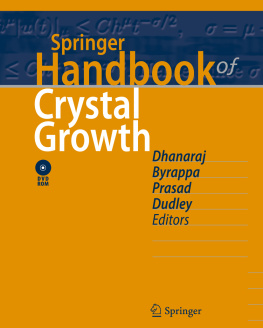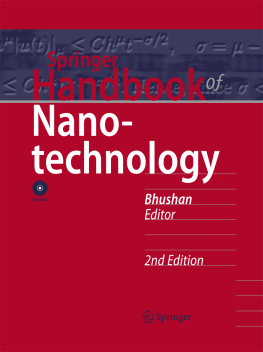Govindhan Dhanaraj , Kullaiah Byrappa , Vishwanath Prasad and Michael Dudley (eds.) Springer Handbook of Crystal Growth 10.1007/978-3-540-74761-1_1 Springer-Verlag 2010
1. Crystal Growth Techniques and Characterization: An Overview
1.1 Historical Developments
Crystals are the unacknowledged pillars of the world of modern technology. They have attracted human civilization from prehistoric times owing to their beauty and rarity, but their large-scale applications for devices have been realized only in the last six decades. For a long time, crystal growth has been one of the most fascinating areas of research. Although systematic understanding of the subject of crystal growth began during the last quarter of the 19th century with Gibbs phase equilibrium concept based on a thermodynamical treatment, man practiced crystal growth and or crystallization processes as early as 1500BC in the form of salt and sugar crystallization. Thus, crystal growth can be treated as an ancient scientific activity. However, the scientific approach to the field of crystal growth started in 1611 when Kepler correlated crystal morphology and structure, followed by Nicolous Steno, who explained the origin of a variety of external forms. Since then crystal growth has evolved steadily to attain its present status. Several theories were proposed from the 1920s onwards. The current impetus in crystal growth started during World War II. Prior to that, applications of crystals and crystal growth technology did not catch the attention of technologists. The growth of small or fine crystals in the early days, which involved uncontrolled or poorly controlled crystal growth parameters without much sophistication in instrumentation or crystal growth equipment, slowly led to the growth of large bulk crystals during World War II. With advancement in instrumentation technology, the attention of crystal growers focused on the quality of the grown crystals and understanding of their formation. Also, tailoring of crystal shape or morphology, size, and properties plays a key role in crystal growth science. In this context it is appropriate to mention nanocrystals, which exhibit desirable physicochemical characteristics. Similarly, the growth of thin films has emerged as a fascinating technology. Further crystal growth research is being carried out in microgravity or space conditions. There are various methods of evaluating the quality of grown crystals. Thus the growth of crystals with tailored physics and chemistry, characterization of crystals with more advanced instrumentation, and their conversion into useful devices play vital roles in science and technology [].
Crystal growth is a highly interdisciplinary subject that demands the collaboration of physicists, chemists, biologists, engineers, crystallographers, process engineers, materials scientists, and materials engineers. The significance of the beauty and rarity of crystals is now well knitted with their symmetry, molecular structure, and purity, and the physicochemical environment of their formation. These characteristics endow crystals with unique physical and chemical properties, which have transformed electronic industries for the benefit of human society. Prior to commercial growth or production of crystals, man depended only on the availability of natural crystals for both jewelery and devices. Today the list of uses of artificially grown crystals is growing exponentially for a variety of applications, such as electronics, electrooptics, crystal bubble memories, spintronics, magnetic devices, optics, nonlinear devices, oscillators, polarizers, transducers, radiation detectors, lasers, etc. Besides inorganic crystal growth, the world of organic, semiorganic, biological crystal growth is expanding greatly to make crystal growth activity more cost-effective. Today, the quality, purity, and defect-free nature of crystals is a prerequisite for their technological application. A reader can get useful information on the history of crystal growth from the works of Scheel [].
Crystal growth is basically a process of arranging atoms, ions, molecules or molecular assemblies into regular three-dimensional periodic arrays. However, real crystals are never perfect, mainly due to the presence of different kinds of local disorder and long-range imperfections such as dislocations. Moreover, they are often polycrystalline in nature. Hence, the ultimate aim of a crystal grower is to produce perfect single crystals of desired shape and size, and to characterize them in order to understand their purity and quality and perfection for end users. Accordingly, crystal growth techniques and characterization tools have advanced greatly in recent years. This has facilitated the growth and characterization of a large variety of technologically important single crystals. Crystal growth can be treated as an important branch of materials science leading to the formation of technologically important materials of different sizes. Hence, it covers crystals from bulk to small and even to fine, ultrafine, and nanoscale sizes. In this respect, crystal growth has a close relationship with crystal engineering, and also polyscale crystal growth is relevant. This concept becomes even more relevant with progress achieved in nanotechnology, wherein the size effect explains changes in the physical properties of crystalline materials with size.













